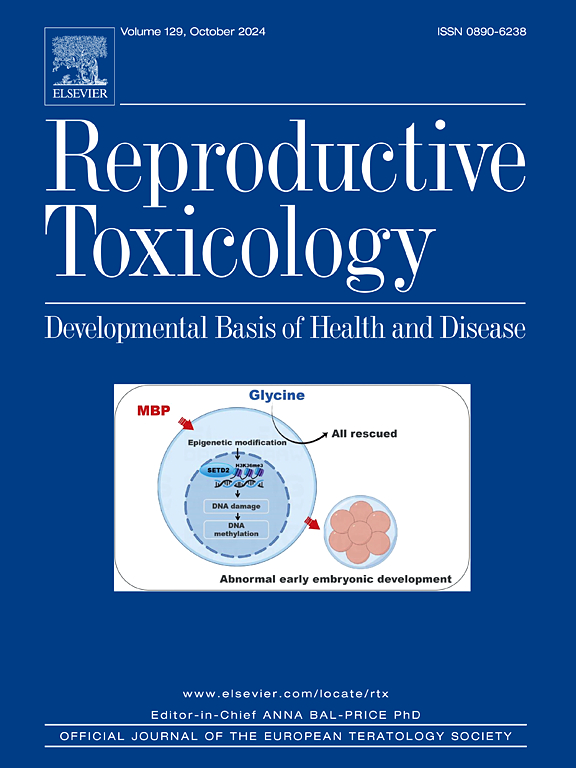Bisphenol-A-induced ovarian cancer: Changes in epithelial diversity, apoptosis, antioxidant and anti-inflammatory mechanisms
IF 3.3
4区 医学
Q2 REPRODUCTIVE BIOLOGY
引用次数: 0
Abstract
This research was designed to study the carcinogenic mechanisms of BPA on ovarian epithelial cells. For four months, mice were treated with low (LD, 1 mg/kg) and high (HD, 5 mg/kg of body weight) doses of BPA on alternate days through oral gavage; the control group was given corn oil through gavaging during 4 months. The histopathological data suggest that repeated BPA administration induces a borderline epithelial neoplasm with altered epithelial morphology with branching papillae. Various epithelial cells (ECs) in ovaries were identified by flow cytometry based on anti-mouse CD74 and podoplanin (PDPL) receptors expression. Three different populations of ovarian epithelial cells were identified: epithelial cells type 1 (PDPL+CD74-,EC1), epithelial cells type 2 (PDPL-CD74+, EC2), and transition epithelial cells (PDPL+CD74+, TEC). The EC1 decreased, but EC2 was increased in BPA-exposed mice. The population of TEC was comparable to that in the control group at the low dose (LD) but decreased in the high dose (HD) BPA-treated groups. A significant increase in PDPL, CD74 receptor expression and apoptosis and necrosis in BPA-treated ovarian cells was seen. The RT-qPCR results suggest that the relative expression levels of pro-apoptotic (Bax and Casp3) and anti-apoptotic Cytc were markedly decreased, but Bcl2 expression was increased. The anti-inflammatory (IFN-γ, TNF-α, TGF-β, IL-6) gene expression was reduced, but NF-kB expression was increased. Hypoxia regulator (Hif-1α and Nrf2) and tumour suppressor genes (p53 and p21) were also decreased. Thus, BPA exposure changes EC diversity, induces mortality and alters antioxidant, apoptotic and inflammatory gene expression in ovary.
双酚a诱导的卵巢癌:上皮多样性、凋亡、抗氧化和抗炎机制的变化
本研究旨在探讨双酚a对卵巢上皮细胞的致癌机制。4个月后,小鼠隔天灌胃低剂量(LD, 1 mg/kg)和高剂量(HD, 5 mg/kg) BPA;对照组大鼠4个月灌胃给予玉米油。组织病理学数据表明,反复给药双酚a诱导交界性上皮肿瘤,上皮形态改变,有分支乳头。利用流式细胞术检测抗小鼠CD74和足素(PDPL)受体的表达,鉴定卵巢上皮细胞(ECs)。卵巢上皮细胞鉴定出三种不同的群体:上皮细胞1型(PDPL+CD74-,EC1),上皮细胞2型(PDPL-CD74+, EC2)和过渡上皮细胞(PDPL+CD74+, TEC)。bpa暴露小鼠的EC1降低,EC2升高。在低剂量(LD) bpa处理组,TEC的数量与对照组相当,但在高剂量(HD) bpa处理组,TEC的数量有所减少。bpa处理后卵巢细胞PDPL、CD74受体表达明显增加,凋亡和坏死明显增加。RT-qPCR结果显示,促凋亡(Bax和Casp3)和抗凋亡Cytc的相对表达水平明显降低,而Bcl2的表达水平升高。抗炎(IFN-γ、TNF-α、TGF-β、IL-6)基因表达降低,NF-kB表达升高。缺氧调节基因(Hif-1α和Nrf2)和肿瘤抑制基因(p53和p21)也降低。因此,BPA暴露改变卵巢EC多样性,诱导死亡,改变抗氧化、凋亡和炎症基因表达。
本文章由计算机程序翻译,如有差异,请以英文原文为准。
求助全文
约1分钟内获得全文
求助全文
来源期刊

Reproductive toxicology
生物-毒理学
CiteScore
6.50
自引率
3.00%
发文量
131
审稿时长
45 days
期刊介绍:
Drawing from a large number of disciplines, Reproductive Toxicology publishes timely, original research on the influence of chemical and physical agents on reproduction. Written by and for obstetricians, pediatricians, embryologists, teratologists, geneticists, toxicologists, andrologists, and others interested in detecting potential reproductive hazards, the journal is a forum for communication among researchers and practitioners. Articles focus on the application of in vitro, animal and clinical research to the practice of clinical medicine.
All aspects of reproduction are within the scope of Reproductive Toxicology, including the formation and maturation of male and female gametes, sexual function, the events surrounding the fusion of gametes and the development of the fertilized ovum, nourishment and transport of the conceptus within the genital tract, implantation, embryogenesis, intrauterine growth, placentation and placental function, parturition, lactation and neonatal survival. Adverse reproductive effects in males will be considered as significant as adverse effects occurring in females. To provide a balanced presentation of approaches, equal emphasis will be given to clinical and animal or in vitro work. Typical end points that will be studied by contributors include infertility, sexual dysfunction, spontaneous abortion, malformations, abnormal histogenesis, stillbirth, intrauterine growth retardation, prematurity, behavioral abnormalities, and perinatal mortality.
 求助内容:
求助内容: 应助结果提醒方式:
应助结果提醒方式:


